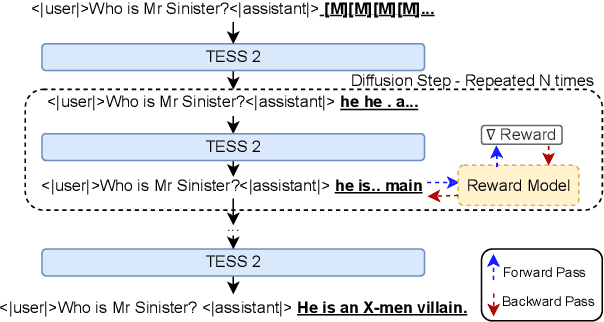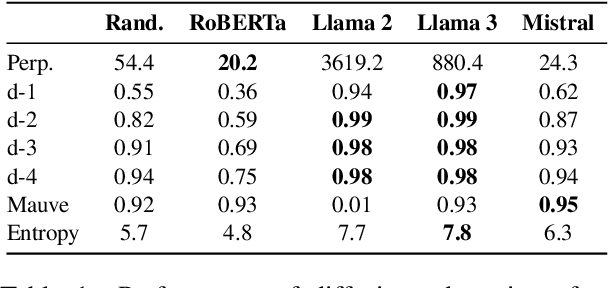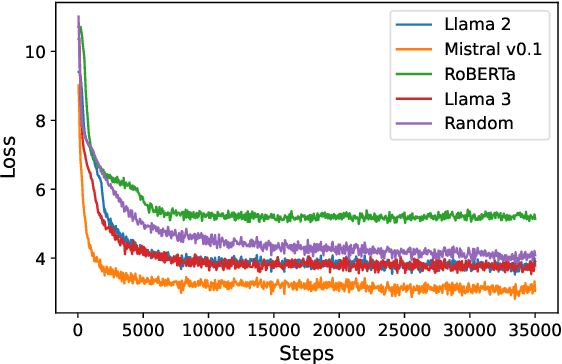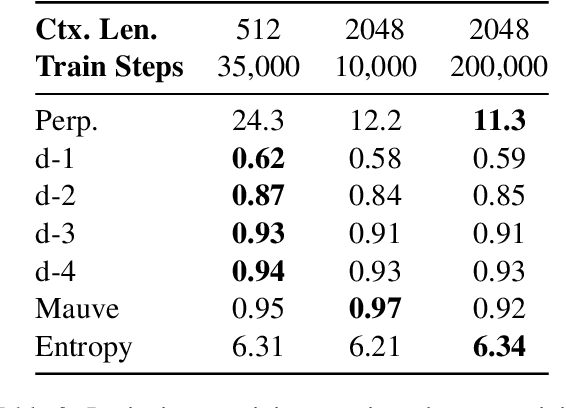Sachin Kumar
BLAB: Brutally Long Audio Bench
May 05, 2025Abstract:Developing large audio language models (LMs) capable of understanding diverse spoken interactions is essential for accommodating the multimodal nature of human communication and can increase the accessibility of language technologies across different user populations. Recent work on audio LMs has primarily evaluated their performance on short audio segments, typically under 30 seconds, with limited exploration of long-form conversational speech segments that more closely reflect natural user interactions with these models. We introduce Brutally Long Audio Bench (BLAB), a challenging long-form audio benchmark that evaluates audio LMs on localization, duration estimation, emotion, and counting tasks using audio segments averaging 51 minutes in length. BLAB consists of 833+ hours of diverse, full-length audio clips, each paired with human-annotated, text-based natural language questions and answers. Our audio data were collected from permissively licensed sources and underwent a human-assisted filtering process to ensure task compliance. We evaluate six open-source and proprietary audio LMs on BLAB and find that all of them, including advanced models such as Gemini 2.0 Pro and GPT-4o, struggle with the tasks in BLAB. Our comprehensive analysis reveals key insights into the trade-offs between task difficulty and audio duration. In general, we find that audio LMs struggle with long-form speech, with performance declining as duration increases. They perform poorly on localization, temporal reasoning, counting, and struggle to understand non-phonemic information, relying more on prompts than audio content. BLAB serves as a challenging evaluation framework to develop audio LMs with robust long-form audio understanding capabilities.
Automated Testing of COBOL to Java Transformation
Apr 14, 2025Abstract:Recent advances in Large Language Model (LLM) based Generative AI techniques have made it feasible to translate enterprise-level code from legacy languages such as COBOL to modern languages such as Java or Python. While the results of LLM-based automatic transformation are encouraging, the resulting code cannot be trusted to correctly translate the original code, making manual validation of translated Java code from COBOL a necessary but time-consuming and labor-intensive process. In this paper, we share our experience of developing a testing framework for IBM Watsonx Code Assistant for Z (WCA4Z) [5], an industrial tool designed for COBOL to Java translation. The framework automates the process of testing the functional equivalence of the translated Java code against the original COBOL programs in an industry context. Our framework uses symbolic execution to generate unit tests for COBOL, mocking external calls and transforming them into JUnit tests to validate semantic equivalence with translated Java. The results not only help identify and repair any detected discrepancies but also provide feedback to improve the AI model.
A Survey on Personalized and Pluralistic Preference Alignment in Large Language Models
Apr 09, 2025Abstract:Personalized preference alignment for large language models (LLMs), the process of tailoring LLMs to individual users' preferences, is an emerging research direction spanning the area of NLP and personalization. In this survey, we present an analysis of works on personalized alignment and modeling for LLMs. We introduce a taxonomy of preference alignment techniques, including training time, inference time, and additionally, user-modeling based methods. We provide analysis and discussion on the strengths and limitations of each group of techniques and then cover evaluation, benchmarks, as well as open problems in the field.
Steering off Course: Reliability Challenges in Steering Language Models
Apr 06, 2025Abstract:Steering methods for language models (LMs) have gained traction as lightweight alternatives to fine-tuning, enabling targeted modifications to model activations. However, prior studies primarily report results on a few models, leaving critical gaps in understanding the robustness of these methods. In this work, we systematically examine three prominent steering methods -- DoLa, function vectors, and task vectors. In contrast to the original studies, which evaluated a handful of models, we test up to 36 models belonging to 14 families with sizes ranging from 1.5B to 70B parameters. Our experiments reveal substantial variability in the effectiveness of the steering approaches, with a large number of models showing no improvement and at times degradation in steering performance. Our analysis demonstrate fundamental flaws in the assumptions underlying these methods, challenging their reliability as scalable steering solutions.
TESS 2: A Large-Scale Generalist Diffusion Language Model
Feb 19, 2025



Abstract:We introduce TESS 2, a general instruction-following diffusion language model that outperforms contemporary instruction-tuned diffusion models, as well as matches and sometimes exceeds strong autoregressive (AR) models. We train TESS 2 by first adapting a strong AR model via continued pretraining with the usual cross-entropy as diffusion loss, and then performing further instruction tuning. We find that adaptation training as well as the choice of the base model is crucial for training good instruction-following diffusion models. We further propose reward guidance, a novel and modular inference-time guidance procedure to align model outputs without needing to train the underlying model. Finally, we show that TESS 2 further improves with increased inference-time compute, highlighting the utility of diffusion LMs in having fine-grained controllability over the amount of compute used at inference time. Code and models are available at https://github.com/hamishivi/tess-2.
Hybrid Preferences: Learning to Route Instances for Human vs. AI Feedback
Oct 24, 2024



Abstract:Learning from human feedback has enabled the alignment of language models (LMs) with human preferences. However, directly collecting human preferences can be expensive, time-consuming, and can have high variance. An appealing alternative is to distill preferences from LMs as a source of synthetic annotations as they are more consistent, cheaper, and scale better than human annotation; however, they are also prone to biases and errors. In this work, we introduce a routing framework that combines inputs from humans and LMs to achieve better annotation quality, while reducing the total cost of human annotation. The crux of our approach is to identify preference instances that will benefit from human annotations. We formulate this as an optimization problem: given a preference dataset and an evaluation metric, we train a performance prediction model to predict a reward model's performance on an arbitrary combination of human and LM annotations and employ a routing strategy that selects a combination that maximizes predicted performance. We train the performance prediction model on MultiPref, a new preference dataset with 10K instances paired with human and LM labels. We show that the selected hybrid mixture of LM and direct human preferences using our routing framework achieves better reward model performance compared to using either one exclusively. We simulate selective human preference collection on three other datasets and show that our method generalizes well to all three. We analyze features from the routing model to identify characteristics of instances that can benefit from human feedback, e.g., prompts with a moderate safety concern or moderate intent complexity. We release the dataset, annotation platform, and source code used in this study to foster more efficient and accurate preference collection in the future.
ComPO: Community Preferences for Language Model Personalization
Oct 21, 2024



Abstract:Conventional algorithms for training language models (LMs) with human feedback rely on preferences that are assumed to account for an "average" user, disregarding subjectivity and finer-grained variations. Recent studies have raised concerns that aggregating such diverse and often contradictory human feedback to finetune models results in generic models that generate outputs not preferred by many user groups, as they tend to average out styles and norms. To address this issue, we draw inspiration from recommendation systems and propose ComPO, a method to personalize preference optimization in LMs by contextualizing the probability distribution of model outputs with the preference provider. Focusing on group-level preferences rather than individuals, we collect and release ComPRed, a question answering dataset with community-level preferences from Reddit. This dataset facilitates studying diversity in preferences without incurring privacy concerns associated with individual feedback. Our experiments reveal that conditioning language models on a community identifier (i.e., subreddit name) during preference tuning substantially enhances model performance. Conversely, replacing this context with random subreddit identifiers significantly diminishes performance, highlighting the effectiveness of our approach in tailoring responses to communities' preferences.
Overriding Safety protections of Open-source Models
Sep 28, 2024Abstract:LLMs(Large Language Models) nowadays have widespread adoption as a tool for solving issues across various domain/tasks. These models since are susceptible to produce harmful or toxic results, inference-time adversarial attacks, therefore they do undergo safety alignment training and Red teaming for putting in safety guardrails. For using these models, usually fine-tuning is done for model alignment on the desired tasks, which can make model more aligned but also make it more susceptible to produce unsafe responses, if fine-tuned with harmful data.In this paper, we study how much of impact introduction of harmful data in fine-tuning can make, and if it can override the safety protection of those models. Conversely,it was also explored that if model is fine-tuned on safety data can make the model produce more safer responses. Further we explore if fine-tuning the model on harmful data makes it less helpful or less trustworthy because of increase in model uncertainty leading to knowledge drift. Our extensive experimental results shown that Safety protection in an open-source can be overridden, when fine-tuned with harmful data as observed by ASR increasing by 35% when compared to basemodel's ASR. Also, as observed, fine-tuning a model with harmful data made the harmful fine-tuned model highly uncertain with huge knowledge drift and less truthfulness in its responses. Furthermore, for the safe fine-tuned model, ASR decreases by 51.68% as compared to the basemodel, and Safe model also shown in minor drop in uncertainty and truthfulness as compared to basemodel. This paper's code is available at: https://github.com/techsachinkr/Overriding_Model_Safety_Protections
MAGNET: Improving the Multilingual Fairness of Language Models with Adaptive Gradient-Based Tokenization
Jul 11, 2024



Abstract:In multilingual settings, non-Latin scripts and low-resource languages are usually disadvantaged in terms of language models' utility, efficiency, and cost. Specifically, previous studies have reported multiple modeling biases that the current tokenization algorithms introduce to non-Latin script languages, the main one being over-segmentation. In this work, we propose MAGNET; multilingual adaptive gradient-based tokenization to reduce over-segmentation via adaptive gradient-based subword tokenization. MAGNET learns to predict segment boundaries between byte tokens in a sequence via sub-modules within the model, which act as internal boundary predictors (tokenizers). Previous gradient-based tokenization methods aimed for uniform compression across sequences by integrating a single boundary predictor during training and optimizing it end-to-end through stochastic reparameterization alongside the next token prediction objective. However, this approach still results in over-segmentation for non-Latin script languages in multilingual settings. In contrast, MAGNET offers a customizable architecture where byte-level sequences are routed through language-script-specific predictors, each optimized for its respective language script. This modularity enforces equitable segmentation granularity across different language scripts compared to previous methods. Through extensive experiments, we demonstrate that in addition to reducing segmentation disparities, MAGNET also enables faster language modelling and improves downstream utility.
WildTeaming at Scale: From In-the-Wild Jailbreaks to (Adversarially) Safer Language Models
Jun 26, 2024



Abstract:We introduce WildTeaming, an automatic LLM safety red-teaming framework that mines in-the-wild user-chatbot interactions to discover 5.7K unique clusters of novel jailbreak tactics, and then composes multiple tactics for systematic exploration of novel jailbreaks. Compared to prior work that performed red-teaming via recruited human workers, gradient-based optimization, or iterative revision with LLMs, our work investigates jailbreaks from chatbot users who were not specifically instructed to break the system. WildTeaming reveals previously unidentified vulnerabilities of frontier LLMs, resulting in up to 4.6x more diverse and successful adversarial attacks compared to state-of-the-art jailbreak methods. While many datasets exist for jailbreak evaluation, very few open-source datasets exist for jailbreak training, as safety training data has been closed even when model weights are open. With WildTeaming we create WildJailbreak, a large-scale open-source synthetic safety dataset with 262K vanilla (direct request) and adversarial (complex jailbreak) prompt-response pairs. To mitigate exaggerated safety behaviors, WildJailbreak provides two contrastive types of queries: 1) harmful queries (vanilla & adversarial) and 2) benign queries that resemble harmful queries in form but contain no harm. As WildJailbreak considerably upgrades the quality and scale of existing safety resources, it uniquely enables us to examine the scaling effects of data and the interplay of data properties and model capabilities during safety training. Through extensive experiments, we identify the training properties that enable an ideal balance of safety behaviors: appropriate safeguarding without over-refusal, effective handling of vanilla and adversarial queries, and minimal, if any, decrease in general capabilities. All components of WildJailbeak contribute to achieving balanced safety behaviors of models.
 Add to Chrome
Add to Chrome Add to Firefox
Add to Firefox Add to Edge
Add to Edge